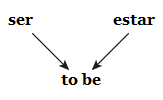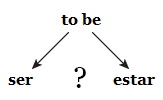|
|||||||||||||||||||||||||||||||||||||||||||||||
 |
|||||||||||||||||||||||||||||||||||||||||||||||
 |
|||||||||||||||||||||||||||||||||||||||||||||||
How to Use Ser and Estar
“To be, or not to be?” was Hamlet’s perplexing question. The Spanish student must grapple with a similar one: “Which ‘to be’ to use?” There are several instances in Spanish where one English word (or tense) can be translated two different ways in Spanish (Por and Para, The Imperfect Tense and the Preterite Tense, Ser and Estar) and the decision you make can affect the meaning of the sentence. Translating from Spanish to English is not a problem because both ser and estar become a form of “to be.” Translating from English to Spanish, on the other hand, is much more difficult because a decision needs to be made on which of the two verbs to use. 

Before we get too much further, let’s take a quick look at the (present tense) conjugations of both verbs: ser:
estar:
Ser is completely irregular, and estar has an irregular yo form along with some irregular accented endings. Ser and Estar: The BasicsSo how do we decide which verb to use? Here’s when we use estar: When to Use EstarHelpful Rhyme: An easy way to think about the verb estar is that it is used to describe temporary conditions and locations. Conditions can be mental, emotional, or physical states of people, animals, and objects. Locations are quite simply where something or someone is. Pepe y Pablo están
en mi dormitorio. Note: Because estar is associated with location, words like “here” or “there” are optional: Jaime no está. (Jaime isn’t here.) “Pepe and Pablo are in my room.” This sentence describes someone’s location, so están (not son) is used. “Emilia is sick.” This sentence is talking about Emilia’s physical condition so está (not es) is used. In both of these situations the condition mentioned is temporary. Presumably Pepe and Pablo won’t always be in my room; hopefully Emilia won’t always be sick. On the other hand ... When to Use SerSince estar deals with temporary conditions, that leaves ser as the verb to use for more permanent situations. Generally speaking, ser is used when dealing with more “inherent” characteristics. That’s a fancy way of saying things which are not likely to change. Mi
coche es amarillo. “My car is yellow.” This is not likely to change. The car probably has been yellow for some time and will continue to be yellow into the future. We wouldn’t expect it to suddenly be another color tomorrow. “Her brothers are very thin.” Again, this is a state that we wouldn’t expect to change quickly. When we think of these brothers, we think of them as being thin and don’t expect them to rapidly put on weight. Notice that in these examples it’s not impossible that the characteristics would change (cars are repainted all the time, and thin people sometimes get bigger). It’s just unlikely to expect that they would soon. The Exception: EventsIt wouldn’t be a rule if it didn’t have an exception, right? To talk about where and when events will take place, we use ser rather than estar, even though we’re dealing with a location. La
fiesta es en la casa de Alejandro. “The party is at Alejandro’s house.” “The soccer games are at the stadium.” Both of these situations might feel like we should be using a form of estar since we’re dealing with where these things are happening, but we use ser with events. Think of ser as meaning “to take place” in these situations. Ser and Estar: Differences in MeaningYour choice of using either estar or ser can also affect the rest of the sentence. Certain adjectives will convey different meanings based on which verb they’re paired with: La
manzana es verde. The first sentence uses ser, so we’re talking about an inherent characteristic of the apple. It should be translated, “The apple is green,” meaning simply that the color of the apple is green. The second sentence uses estar, so we’re dealing with the apple’s current condition. This sentence should be translated something along the lines of, “The apple is not ripe,” meaning that it still needs to ripen up and turn red. Another example: ¿Cómo eres
tú? Both of these sentences could be translated exactly the same way in English, “How are you?” However, since the first sentence uses a form or ser, the implied question is not “How are you right now?” but “How are you usually?” or better yet, “What are you like?” The second question is the more familiar “How are you?” or “How are you doing?” Some other examples:
You can use the differences between ser and estar to comment on changes from what you consider normal. Los coches son muy caros. Marisól es delgada. Ser and Estar: Other UsesSee also: The Present & Imperfect Progressive Progressive ConjugationsUse estar in present progressive and imperfect progressive conjugations: ¡Yo te estoy hablando! Ella estaba llamándome. Time, Days, and DatesUse ser when talking about the time, days, and dates: ¿Qué hora es? Son las diez. Hoy es sábado. Es el 29 de septiembre. PossessionUse ser when talking about possession: El sombrero es del Sr. Fajardo. El coche es de Pancho. Material UsedUse ser when talking about the material something is made of: Mis anillos son de oro. Estas cajas son de cartón. Nationality and OriginUse ser when talking about nationality or place of origin: Ronaldo es nicaragüense y su amigo es argentino. Marta
es de Miami. ¿Estas camisas son de Guatemala? Occupation, Religion, and Political AffiliationUse ser when talking about occupation and religious or political affiliation: Soy
abogado. ¿Qué eres tú, Manuela? Su familia es católica pero ella es protestante. Él es republicano y su esposa es demócrata. Passive VoiceSee also: The Passive Voice in Spanish Use ser in passive voice constructions: Tres casas son construidas cada semana. La puerta fue cerrada por el viento. Impersonal ExpressionsUse ser in impersonal expressions: Es importante tomar buenos apuntes. Es difícil estudiar con tanto ruido. Other TensesAll of the present tense ser and estar rules apply to other tenses as well: Yo estaba muy enfermo. La
boda será en la catedral. ¿Qué hora era? |
|||||||||||||||||||||||||||||||||||||||||||||||
 This work by Spanish411.net is licensed under a Creative Commons Attribution-NonCommercial-ShareAlike 4.0 International License. This work by Spanish411.net is licensed under a Creative Commons Attribution-NonCommercial-ShareAlike 4.0 International License. |



